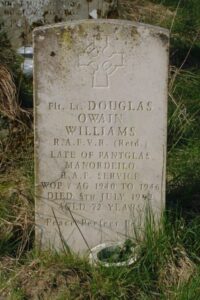The peaceful Hamlet of Taliaris sits in the Towy Valley, about three miles north of Llandeilo. Taliaris was home to the Peel family, relatives of the late Prime Minister Sir Robert Peel, and two of the sons of the house died during the Great War. The War Memorial, as befits such a great donating family, is an impressive structure, with marble panels bearing the names of the fallen. Many thanks to Dave Hanson for supplying the photo of the Memorial.
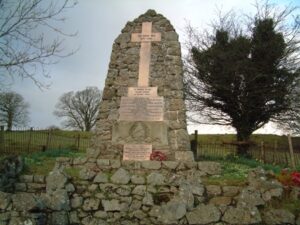
The Great War, 1914-1918
Henry Jones, Private, 474271, Canadian Expeditionary Force. Henry was born on 21 July 1884, the son of William and Gwenllian Jones, of Bank-y-Gwin, and had emigrated to Canada prior to the outbreak of war. He enlisted at Saskatoon on 3 April 1916 into the 72nd Battalion (British Columbia), Canadian Infantry, which was part of the 12th Brigade, 4th Canadian Division. Henry would have arrived in France in time to take part in the Divisions first battle at Le Transloy, on the Somme, in October 1916. They then fought at the Battle of the Ancre Heights, where the Canadians captured Regina Trench, before taking part in the Battle of the Ancre. Henry was wounded in action at the Battle of the Ancre, and died of wounds on 16 November 1916, aged 32. He is buried in Aveluy Communal Cemetery Extension, France.
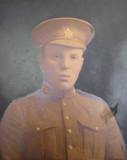
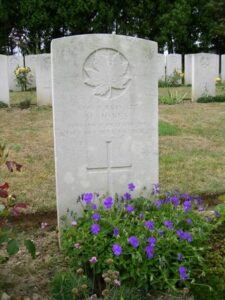
John Jones, Private, 46533, Welsh Regiment. John was the son of Thomas and Hannah Jones, of Pwllau, White Square, Taliaris. He enlisted at Swansea into the army and was posted to France at sometime in 1916, joining the 9th Battalion, Welsh Regiment, which was attached to 58 Brigade, 19th (Western) Division. The division saw terrible fighting on the Somme that year, before moving to Ypres, and took part in the Battle of Messines the following year. John was killed in action during the Battle of the Menin Road, on 21 September 1917, aged 31. His body was lost on the muddy Flanders Battlefield, and so he is remembered on the Tyne Cot Memorial, Belgium.
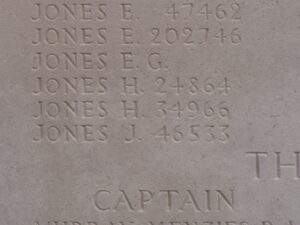
Alan Ralph Peel, Second Lieutenant, Nigeria Regiment. Alan was born on 7 July 1886, the son of Herbert and Mary Peel of Taliaris. He was educated at Cheltenham College and at Sandhurst, from where he was commissioned as a Second Lieutenant into the South Wales Borderers on 24 January 1906. He served with the 1st SWB in India and at Pretoria and in February 1911 was attached to the South African Mounted Infantry. Upon the outbreak of the Great War he was serving as Captain in the 5th Battalion of the Nigeria Regiment. He was killed in action while leading a bayonet charge at Kosseoa on 17 November 1914 aged just twenty eight. He was buried in Cameroon by a French officer, who served with him, but his grave could not be maintained and he is now commemorated on the Zaria Memorial, Nigeria. His brother, Lieutenant Robert Lloyd Peel, MC, was killed at Ypres on 3 September 1917.
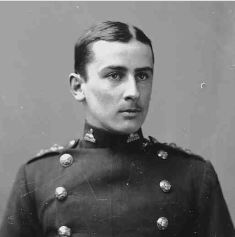
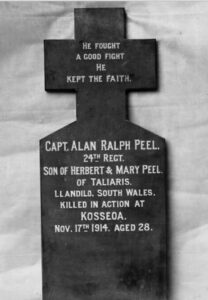
Robert Lloyd Peel, MC, Lieutenant, Royal Field Artillery. Robert was born on 11 June 1889, the third son of Herbert and Mary Peel of Taliaris. After his education at Malvern College, he settled at Madupatti, India in 1909, where he ran a tea plantation. At the outbreak of war, Robert returned to England, where he obtained a commission into the Royal Field Artillery on 23 December 1914, as a Second Lieutenant. He served in Gallipoli from August 1915, and served there until after the evacuation, when he returned to Egypt and then to France in July 1916. In France he served with 58 Brigade, 11th (Northern) Division. The Division was fighting during the Battle of Passchendaele, near Poelcappelle, when Robert died of wounds sustained that same day, on 3 September 1917. He lies in Bard Cottage Cemetery, near Ypres. He had been awarded the Military Cross (London Gazette 21 December, 1916) for conspicuous gallantry in action, when he and a sergeant rescued several men from a burning gun pit, and extinguished the fire.
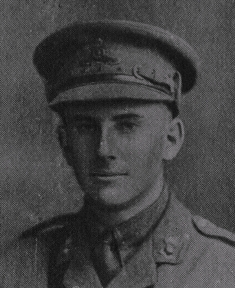
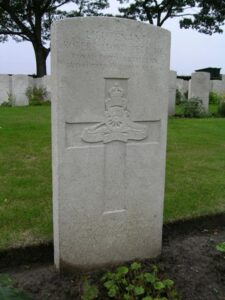
Herbert Pritchard Thomas, Private, 53067, Royal Welsh Fusiliers. Herbert was the son of William and Jane Thomas, of Llandeilo. He married Mabel Dixon in 1905, and the couple resided at Devonshire House, Llandeilo before moving to 1, Standard Villa, Trethomas, Bedwas, Monmouth. Herbert enlisted at Maesteg into the 1/5th Battalion, Royal Welsh Fusiliers, attached to 158 Brigade, 53rd (Welsh) Division. The Division landed at Suvla Bay on 8 August 1915 and fought there until evacuation in December 1915 after suffering terrible casualties. They then moved to Egypt, where they reformed, and began the move into Palestine in early 1917. Herbert was aboard the Troopship HMT Transylvania when she was torpedoed in the Mediterranean on 4 May 1917, and sank. Herbert was 37 years old when he died that day. His body must have been recovered from the sea, and he is buried at Oneglia Town Cemetery, Italy.
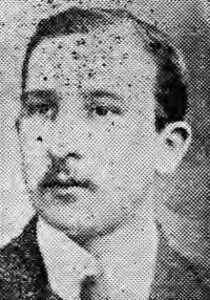
Thomas Rees Thomas, Private, 39304, Suffolk Regiment. Thomas was the son of David and Elizabeth Thomas, of Pantsoar, Salem, Llandeilo. He enlisted at Lambeth into the army and was posted to France, joining the 2nd Battalion, Suffolk Regiment. The battalion had been with the BEF in France since the Battle of Le Cateau, and on 25 October 1914 they joined 8 Brigade, 3rd Division. Thomas would have joined the battalion in 1916, and fought throughout the Somme Offensive. In March 1917 the division was at Arras, and took part in the Battles of the Scarpe, and the Battle of Arleux. Later in the year they moved north, fighting at Third Ypres in the Battles of the Menin Road and Polygon Wood, and they moved south again, where they fought at the Battle of Cambrai. The Division remained in the area after the battle, and was caught up there in the German Spring Offensive of 21 March 1918. Thomas was wounded at some time during the next few chaotic days of the Battle of St. Quentin, and died of wounds on 14 April 1918. He was just 19 years old, and is buried at Pernes British Cemetery, France.
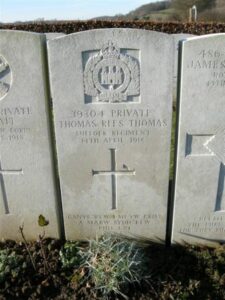
Joshua Williams, Private, 633812, London Regiment. Joshua was born at Llansadwrn in November 1886, the son of William and Eliza Williams. He worked as a Draper, residing at Ty Coch, White Square, Taliaris, Llandilo. Joshua enlisted on 18 November 1915 into the 15th Battalion, London Regiment, and on 5 July 1916, he embarked with the Battalion for France, where he transferred to the 20th Battalion, London Regiment, attached to 141 Brigade, 47th (London) Division. The Division fought on the Somme that year, through the Battles of Flers-Courcelette and Le Transloy, where they captured Eaucourt L’Abbe, and attacked the Butte de Warlencourt. Joshua took ill after these actions, and was admitted to the 2nd Australian General Hospital at Boulogne with influenza. On 2 November 1916 he returned to England, and spent the next few months at the 2nd General Eastern Hospital, Brighton. Joshua was discharged from the army on 26 June 1917, owing to ill health, and was transferred to Beechwood House Hospital, Newport, where he sadly died on 17 September 1917, suffering from Cardiac Failure. He is buried at Taliaris (Holy Trinity) Churchyard. Joshua was accepted for commemoration by the CWGC on 27 May 2011 after his case was put forward to the CWGC by Dave Hanson, and a new headstone has recently been erected by them.
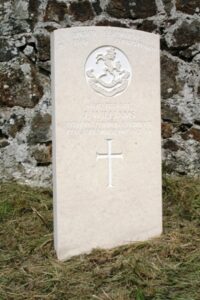
World War Two, 1939-1945
Ronald Lloyd Davies, First Radio Officer, Merchant Navy. Ronald was born in Manordeilo in 1918. He served with the Merchant Navy as a radio officer and had set up home with his wife Iris Elizabeth Mary Davies at 93, Prince of Wales Avenue, Southampton. Ronald served aboard the Cardiff registered steam tanker SS President Sergent, which had been seized by the Admiralty upon the fall of Belgium in 1940. On 18 November 1942 President Sergent was steaming with Convoy ONS-144 south-east of Cape Farewell, when she was torpedoed and sunk by the German submarine U-624 with the loss of 20 lives. Ronald was 24 years old when he died that day and is commemorated on the Tower Hill Memorial, London.
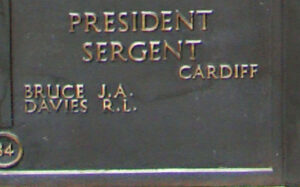
Murray Shuldham-Legh, Major, 5320, The Queen’s Royal Regiment (West Surrey). Murray was born on 4 December 1895, the son of Colonel Harry and Frances J. Shuldham-Legh. He was commissioned into the infantry on 20 November 1914, and served throughout the Great War with the Queen’s (Royal West Surreys). Murray married Irene Gage in 1923, but the couple divorced in 1928, and he then married Julia Ashwell Semple in 1934, the couple having a son, Murray Shuldham-Legh twelve months later. Murray served again during World War Two, but died at Taliaris on 24 September 1942, aged 46. Murray is buried at Taliaris (Holy Trinity) Churchyard. Murray was a member of the MCC, and is commemorated on the War Memorial at Lords Cricket Ground.
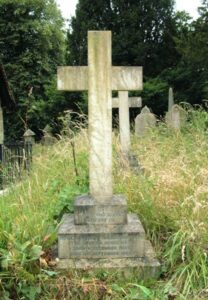
Hubert Gwyn Williams, Sergeant (Pilot), 1394323, Royal Air Force Volunteer Reserve. Hubert was the son of Joseph and Sarah Williams, of Manordeilo. He trained as a pilot and was posted to 138 Squadron, Royal Air Force, which flew the Handley Page Halifax V, based at RAF Tempsford and flew missions to support SOE agents in occupied Europe. On 19 December 1943 Hubert was flying Halifax BB364, Serial NF-R on a training flight, when he collided with chimney near Henlow, Bedfordshire and crashed while attempting to make a forced landing, killing all the crew. Hubert was 21 years old and was brought home for burial in Taliaris (Holy Trinity) Churchyard.
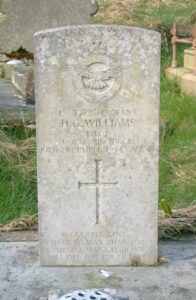
John Clyde Williams, Aircraftman 1st Class, 1029551, Royal Air Force Volunteer Reserve. John was the son of Robert and Margaret Mary Williams of Manordeilo School House. He married Phyllis May Coombes, of Llandeilo in 1929. John served with 9 Squadron, Royal Air Force, which was equipped with the Avro Lancaster I, based at RAF Waddington. He died at Haverfordwest Hospital on 12 February 1943, aged 39 and was brought home for burial in Manordeilo (St. Paul) Churchyard.
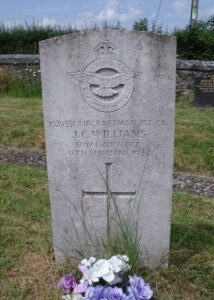
Post WW2
Also buried in Taliaris Churchyard is a former World War Two airman who survived the conflict but died many years after the war.
Douglas Owain Williams, Flight Lieutenant, 169314, Royal Air Force Volunteer Reserve. Douglas was born on 4 June 1920 and lived at Pantglas, Manordeilo. He was commissioned into the Royal Air Force Volunteer Reserve in 1940 and served during the war as a Wireless Operator/ Air Gunner. He served with the RAF until 1946 and was placed on the reserve list and on 16 July 1951 was re-appointed to the reconstituted RAFVR. Douglas died in London on 5 July 1992 and was buried in Taliaris Churchyard. His grave is marked by a headstone made in the same style and material as the standard CWGC stone.
